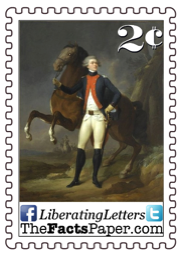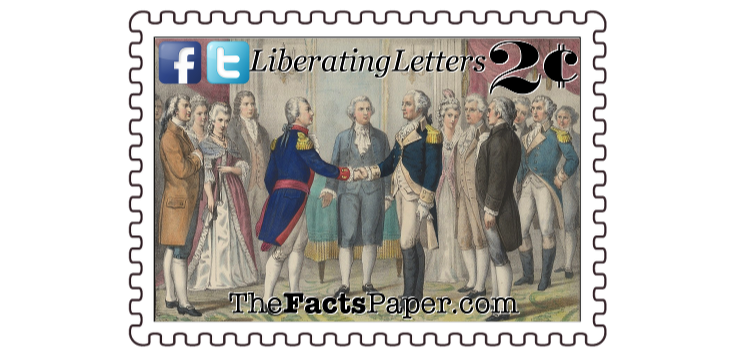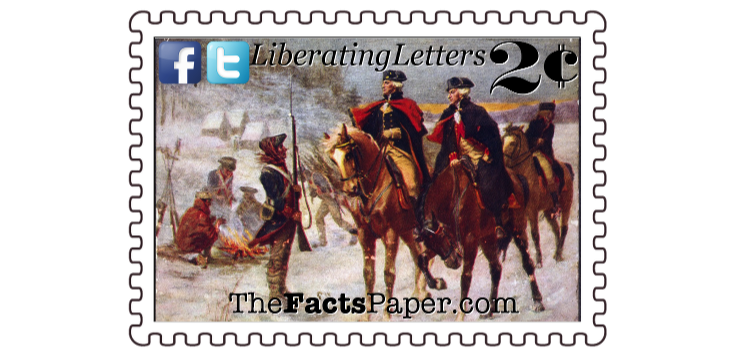It did not take long for Lafayette to see action. The first battle he participated in was the Battle of Brandywine on September 11. (see Pivot Points) While the Patriots fought valiantly, they could not defeat the overwhelming number of British troops. Yet despite begin shot in the leg, Lafayette stood his ground to give encouragement and directions during their retreat, winning the respect and esteem of the Continental Army. The days following, the Red Coats moved to seize the American capital of Philadelphia as Washington headed towards Valley Forge. (see Let Liberty Ring!) Citing "bravery and military ardour,” Washington recommended to Congress to assign the young officer his own command, which they granted.
That winter, Lafayette joined Washington at Valley Forge, where they both endured the hardships of the winter. (see Sergeant Molly) It is also where Lafayette and General Peter Muhlenberg witnessed Washington on bended knee in prayer. (see God’s Divine Providence and Who Among You Is With Me?) Sent to invade Quebec from Albany, New York, in wintertime by the Board of War, Lafayette quickly abandoned the plan as he discovered an inadequate amount of troops in Albany. Writing Washington of his return to Valley Forge, he did not leave before recruiting the Oneida tribe over to the colonists’ side.
To Lafayette’s delight, Franklin secured the much needed support from France in signed treaties in early 1778. By springtime, France publicly recognized America’s Independence. With French ships on the way, the British made plans to evacuate Philadelphia, but tried to capture Lafayette, who was conducting a exploration near Barren Hill, in the meantime. Quick thinking allowed him and his troops to outwit the British and escape what is now called Lafayette Hill. However, they would meet again at the Battle of Monmouth a month later as the British marched to New York. (see Sergeant Molly)
As the French arrived, Lafayette expected to command a joint Franco-American force, yet French Admiral d’Estaing would not here of it. Tensions rose between the admiral and the Americans as both sides tried to assume control. Lafayette and John Hancock (see Acts Of Oppression and The Shot Heard 'Round The World) quickly rushed to Boston to calm Bostonians furious with d’Estaing’s perceived treason of abandoning American troops, with Congress praising his quick and successful actions.
That fall, Lafayette requested a leave of absence from Washington and Congress, which was granted. Arriving in Paris in February of 1779, King Louis XVI placed him under house arrest for eight days for leaving against his orders. However, it was basically for show as Lafayette was already considered a hero and was soon invited on hunting outings with the king. Authorized by the Continental Congress, Franklin’s grandson presented him with a gold sword in recognition of his contributions to America. At home, Lafayette met his daughter, Anastasie, born after he left for America. Before leaving again a year later, Lafayette welcomed their only son, Georges Washington Lafayette, into the family.
Together, Franklin and Lafayette obtained 6,000 French soldiers to be sent under the command of General Jean-Baptiste de Rochambeau. This time, Lafayette would become the liaison between Washington and Rochambeau to avoid any more conflicts over command. Returning to Boston on April 27, 1780, Lafayette arrived to discover the war was going poorly for the Patriots, especially in the south, and by that fall, Benedict Arnold had become a turncoat. (see A Tale Of Two Patriots) The tides turned for the Patriots following the Battle of Cowpens on January 17, 1781, prompting Washington to order Lafayette and Baron von Steuben to combine forces and go after Arnold. (see Morgan’s Miracle) If Arnold was caught, Washington ordered Lafayette to hang him immediately.
Under a plan devised by von Steuben, Washington placed Lafayette in control of forces in Virginia in hopes of trapping Cornwallis. However, Washington refrained from notifying Lafayette upon fears of the messages being intercepted by the British. Thinking he was being left out of critical battles, Lafayette sent a letter to the French Ambassador in Philadelphia, which was forwarded to the king. Lafayette complained of ill-equipped troops prompting King Louis to respond by approving an abundance of much needed supplies. While not part of Washington’s plan, the unexpected French aid would prove vital to defeating Lord Cornwallis.
Battles continued throughout the summer and fall until Washington joined Lafayette on September 14, 1781. When the French fleets arrive on September 28, Cornwallis was surrounded in Yorktown by land and by sea, beginning the Siege of Yorktown. It ended October 19 with Cornwallis’ surrender to Washington. (see On A Mislead And A Prayer)
As several minor battles commenced, especially by those unaware of the surrender, Washington ordered Lafayette to Philadelphia where Congress designated him the advisor for Franklin in Paris, John Jay in Madrid, Spain, and John Adams in The Hague, Netherlands. However, by the end of the year, he was back in France as the “Hero of Two Worlds”. In September, he and his wife welcomed their forth child, Marie-Antoinette Virginie, after Washington’s home state.
Lafayette left the new country a beloved hero of Americans, and rightfully so. Not only did he serve at no pay, he used his personal funds to supply his troops with necessary provisions. Furthermore, he was motivated not by his own glory, but by an idea he truly believed in and was willing to fight for, even though it did not directly benefit his own nation.
While today’s teenagers and twenty somethings melt down over a word and run to their safe spaces because they can’t handle the simplest opposing view, the Marquis de Lafayette left a young wife and child to actually fight for a cause. Liberty, my heart aches knowing the state of our country you are growing up in. Your grandparents and great-grandparents had the spirit, fortitude and integrity of a Lafayette. (see A Hero’s Story and The Forgotten Battle) However, today’s society wants so desperately to shame you into despising them because of it. My true fear is if America’s course is not changed, we will turn into France with their revolution. (see Storming The Bastille and Reign of Terror) As you will see in part II, Hero Of Two Worlds - The French Years, under similar chaos and pressure we are feeling now, Lafayette held to his principles and character, even to the detriment of his personal wealth and properties. I pray not only you, but millions of other Americans, have the same fortitude.
That’s my 2 cents.
Love,
Mom
July 31, 2018
Dear Liberty,
Gilbert stood firm as he faced Congress. At only 19 years of age, he had more courage and determination then many men twice his age. The Congressmen wavered as they contemplated his proposal. This wasn’t the first time a foreign officer offered their services to the United States, usually seeking glory for themselves. However, Gilbert was different. Therefore, when he threw in the extra bonus of serving without pay, debate was over. Congress commissioned the Marquis de Lafayette into the Continental Army on July 31, 1777.
Marie-Joseph Paul Yves Roch Gilbert du Motier, Marquis de Lafayette, was born September 6, 1757, in Chavaniac, France, to wealth, privilege, and a long heritage of warriors that is considered possibly one of the oldest lineages in France. In 1429, Gilbert de Lafayette III was Joan of Arc’s companion-at-arms during the Siege of Orléans. (see Joan The Maid) Tradition holds that during the Sixth Crusade, one of his ancestors obtained the crown of thorns. In addition, Lafayette’s maternal great-grandfather commanded King Louis XV’s personal horse guard, the Mousquetaires due Rói, or Black Musketeers, until his death in 1770.
Lafayette was only 2 years old when his father, Michel, was hit by a British cannonball on August 1, 1759, during a battle in the Seven Years’ War. Because of this, Lafayette inherited the title of Marquis as well as a contention for the British. His mother left him in the care of his paternal grandmother until age 11, upon which he joined his mother and great-grandfather in Paris. At that time, he began studies at the College du Plessis, while his great-grandfather arranged for him to train Musketeers. In April of 1770, while still just 12, Lafayette lost both his mother and great-grandfather, and shortly after an uncle. These deaths granted him substantial wealth and a considerable income as Marquis.
Lafayette remained in the care of another uncle until a marriage was arranged between him and Marie Adrienne Françoise in 1773. When they married the next year at ages 16 and 14 respectively, they had spent enough time together to genuinely fall in love.
Through the help of his great-grandfather and then his father-in-law, the Duc d’Ayen, Lafayette received multiple commissions and assignments, including positions with the Musketeers and the Noailles Dragoon’s. Furthermore, he received an education at top universities beginning at age 12. He always proved worthy of the appointments and studies.
Over the next few years, Lafayette continued to grow and advance in his military career as well as welcoming his first daughter. By the time he received the rank of captain in the Dragoon’s upon his 18th birthday, a promised wedding present, Lafayette was well behind the American people’s fight for freedom, claiming, “My heart was dedicated.”
King Louis XVI and his foreign minister, Comte Charles de Vergennes, began meeting with American envoys, such as Silas Deane, at the beginning of the American Revolution. Still aggravated over their loss in the Seven Year’s War, the French sought to regain favor with the Americans, while obtaining revenge against their longtime foe, by them sending officers. Lafayette convinced Deane to enlist him in the Continental Army, which occurred on December 7, 1776, under the rank major general. Unfortunately, Britain discovered France’s plans to supply officers and aid, threatening another war if it commenced.
The Duc strongly disapproved of his son-in-law’s actions. Sending him to meet King George III, Lafayette went into hiding upon his return. The Duc then convinced King Louis XVI to issue a decree denying French officers, and specifically Lafayette, from going to America. Despite the obstacles, Lafayette purchased his own boat, Victoire, since Deane did not have the funds to send him. Evading arrest, Lafayette set sail for America on April 20, 1777, leaving his pregnant wife and daughter, who died in 1778, taking other officers with him. Two months later, they landed on North Island, South Carolina, on June 13, 1777. Following a two week stay there, Lafayette headed north to Philadelphia.
A multitude of French officers sent by Deane had already flooded the Continental Congress, many of which could not speak English and most looking for personal prestige despite their minimal experience. Therefore, when Lafayette stood before them, they were not immediately impressed, yet his credentials and minor English skills were impressive, though he wouldn’t be fluent for another year. Congress soon embraced the 19-year-old after he offered to serve without pay. Coming with Benjamin Franklin’s blessings, who replaced Deane, Congress commissioned him as a major general. When General George Washington met him a week later at a dinner held August 5, he was quite impressed with the young soldier. Washington appointed Lafayette to his staff as aide-de-camp, or right hand man. Washington quickly became Lafayette’s mentor and a father-figure.
HERO OF TWO WORLDS:
THE AMERICAN YEARS





